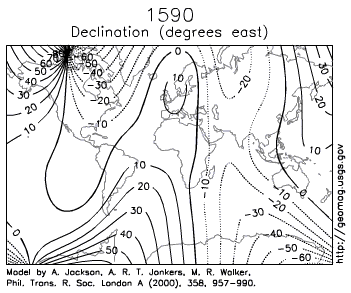How much distance is there between True North and Magnetic North Poles?
This question is not as simple as it seems, and a few minutes of googling did not drop the answer in my lap.
A comment at I never adjust for true north. Is this bad practice? suggesting that:
True north and magnetic north are basically the same thing
started me on a search for a quality answer I could use in a response. I believe the distance between them is larger than size of many small countries, so not sure I would call them basically the same thing.
How much distance (miles/kilometers) is there between True North(Geographic) and Magnetic North Poles?
3 answers
You are accessing this answer with a direct link, so it's being shown above all other answers regardless of its score. You can return to the normal view.
The distance between the magnetic north and geographic north poles is not important for navigation purposes. What matters is the angle between them, which is called the magnetic variation or magnetic declination.
The magnetic variation varies depending on where you are on earth, and also changes slightly from year to year. In Pittsburgh, Pennsylvania, it's approximately 9° west.
In some places, if you are standing at a point that is collinear with the two poles, the magnetic variation is 0°. On the other hand, very close to the magnetic pole, it could be anything: compasses are nearly useless there.
For aviation and navigation, correcting for the magnetic variation is crucial. For hiking, probably not so much (in most places on earth), since you're not going to be following a constant bearing for miles and miles.
This post was sourced from https://outdoors.stackexchange.com/a/10352. It is licensed under CC BY-SA 3.0.
0 comment threads
Magnetic pole
The distance from the rotational north pole varies over time
By the time you read this, the north magnetic pole could be half the circumference of the planet away from the true (i.e. rotational) north pole. Thats over 20,000 km apart. It has been in the past. See magnetic pole reversal and rate of transition.
Declination
More important than the actual position of the magnetic north pole is the direction your magnetic compass points at various places on Earth - they don't all point towards the magnetic north pole - magnetic north is a local attribute which varies from place to place (and from year to year)

In many parts of the world, magnetic declination is more than 10 degrees, in some places much more - this is sufficient to cause hikers difficulties.
This post was sourced from https://outdoors.stackexchange.com/a/10356. It is licensed under CC BY-SA 3.0.
0 comment threads
They're absolutely NOT the same thing.
The distance varies. But it's about 500 miles. (The North Pole: Location, Weather, Exploration … and Santa).
Since its discovery in 1831, the magnetic North Pole has been around Canada’s Ellesmere Island, about 500 miles (800 kilometers) from the geographic North Pole.
This post was sourced from https://outdoors.stackexchange.com/a/10346. It is licensed under CC BY-SA 3.0.





















0 comment threads